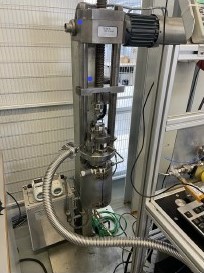Based on the high extrusion of PTFE packings at higher temperatures during comparison tests of packing sets and lengths, the Packings Division decided to investigate methods to reduce PTFE extrusion. Tighter-tolerated sintered PTFE discs have been forwarded to Amtec to repeat the ISO 15848 CO1 test using these as end rings. At DHBW Mannheim University, a test with expanded graphite packings using hydrogen has been completed. The results will be compared to a similar test with helium. The testing of a plastic-free solution for packing packaging provided by Burgmann Packings, as part of the plastics reduction project, will be continued with additional members.

Packing test rig at DHBW Manheim.
The Expansion Joints Division is working with our website developer to implement the configurator tool for selecting standard fabric expansion joint solutions on the divisional website. A first prototype version will be discussed at the next division meeting. The training presentation “Introduction to Fabric Expansion Joints” will be split into small sections and reviewed by dedicated members.
The Mechanical Seals Division has finalised two documents concerning mechanical seal emission performance. After review by all members, they will be available in the Knowledgebase. Three additional training course modules focusing on single and dual mechanical seals, as well as containment seals, will also be reviewed and forwarded to David to generate the voiceover. In addition, two articles for publication in a pump magazine are under review.
The Flange Gasket Division is continuing to compare test results for hydrogen and helium leakage performance for different gasket types. The next paper generated will compare results for PTFE-based gaskets. Further changes and updates in standards like EN 1514-6 and ASME BS 16.20 have been reviewed and discussed. For the plastics reduction project, alternatives to plastic spacers for spiral wound gaskets based on silicone and biodegradable plastic have been checked. The problem is still the higher prices. Sandy asked members for their quantities to get new quotes with better quantity discounts. The work on the third training course on gasket selection continues. The slides are finished, but better pictures and graphs are needed.
The Elastomeric & Polymeric Seals Division is continuing work on the Arrhenius project for the lifetime prediction of elastomeric seals with Cetim. Testing with hydrogen will be added to the project. The training presentation to introduce elastomeric seals is still being worked on.
Ralf Vogel,
Technical Director, ESA
